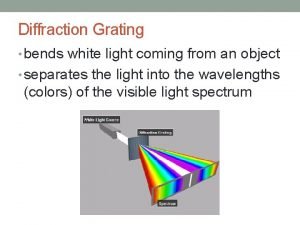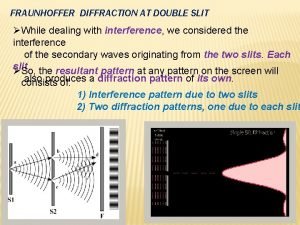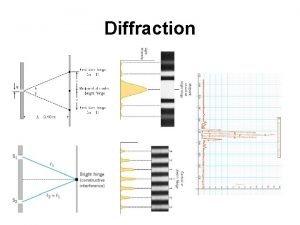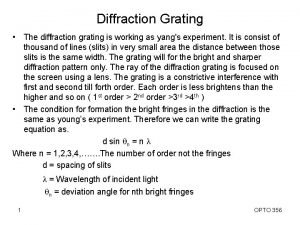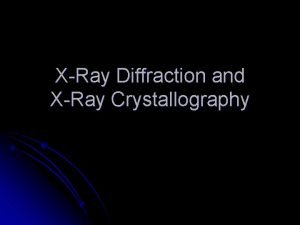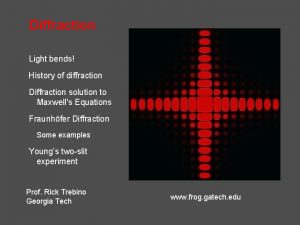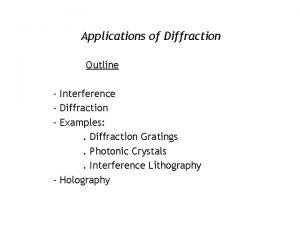Diffraction 27 7 The Diffraction Grating Diffraction grating











- Slides: 11

Diffraction

27. 7. The Diffraction Grating Diffraction grating is an arrangement consisting of a large number of parallel, closely spaced slits. Gratings with as many as 40 000 slits per centimeter can be made, depending on the production method. In one method a diamond-tipped cutting tool is used to inscribe closely spaced parallel lines on a glass plate, the spaces between the lines serving as the slits.

Double Slit & Grating The bright fringes produced by a diffraction grating are much narrower than those produced by a double slit. Note three small secondary bright fringes between the principal bright fringes of the grating. For a large number of slits, these secondary fringes become very small.

When sunlight falls on a diffraction grating, a rainbow of colors is produced at each principal maximum (m = 1, 2, …). The central maximum (m = 0), however, is white but is not shown in the drawing.

Example 9 Separating Colors with a Diffraction Grating A mixture of violet light (λ = 410 nm in vacuum) and red light (λ = 660 nm in vacuum) falls on a grating that contains 1. 0 × 104 lines/cm. For each wavelength, find the angle θ that locates the first-order maxima.

A grating spectroscope

27. 8. Compact Discs (CD), Digital Video Discs (DVD), and the Use of Interference The operation of CD’s and DVD’s uses interference effects. The bottom surface of the disc carries information in the form of raised areas (“pits”) and flat areas (“land”) along a spiral track. A CD or DVD is played by using a laser beam that strikes the bottom surface and reflects from it. The reflected light intensity fluctuates as the pits and land areas pass by, and the fluctuations convey the information as a series of binary numbers (zeros and ones). To make the fluctuations easier to detect, the pit thickness t is chosen with destructive interference in mind.

Three-beam tracking A three-beam tracking method is sometimes used in CD players to ensure that the laser follows the spiral track correctly. The three beams are derived from a single laser beam by using a diffraction grating.

Grating in Nature Not all diffraction gratings are commercially made. Nature also creates diffraction gratings, although these gratings do not look like an array of closely spaced slits. Instead, nature’s gratings are the arrays of regularly spaced atoms that exist in crystalline solids.

Why X-rays? Typically, the atoms in a crystalline solid are separated by distances of about, 1 Å = 1 x 10 -10 m. Crystalline array of atoms act like a grating with roughly this “slit” spacing. The appropriate wavelength for diffraction is found to be in the X-ray region of the EM spectrum.

X-Ray Diffraction of Crystals (a) (b) The X-ray diffraction patterns from (a) crystalline Na. Cl and (b) crystalline DNA. This image of DNA was obtained by Rosalind Franklin in 1953, the year in which Watson and Crick discovered DNA’s structure. (a: Courtesy Edwin Jones, University of South Carolina; b: © Omikron/Photo Researchers)
